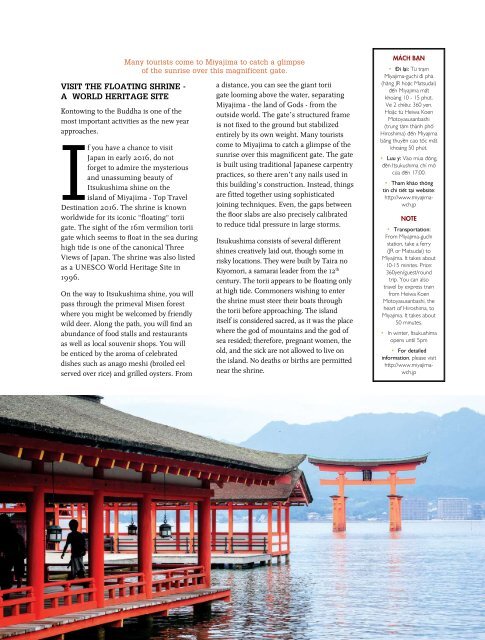TRAVELLIVE 2-2016
I have a three-year old daughter. To teach her basic science knowledge, I always play some interesting games with her. One of her most favorite games is “raining ice cube”. We put an ice cube above a glass of a little hot water. Some seconds later, tiny water droplets will fall down like a lovely “rain”. February comes, new season greets us with drizzling rain whose tiny droplets dampen our hair and shoulders, running down our windows and blurring the world across the pane. Once my daughter woke up early in the morning and pressed her face against the glass pensively, and asked me “Mommy Mommy, there are some ice cubes on our roof, right? Our house is warmer so it rains like this, huh?”
I have a three-year old daughter. To teach her basic science knowledge, I always play some interesting games with her. One of her most favorite games is “raining ice cube”. We put an ice cube above a glass of a little hot water. Some seconds later, tiny water droplets will fall down like a lovely “rain”. February comes, new season greets us with drizzling rain whose tiny droplets dampen our hair and shoulders, running down our windows and blurring the world across the pane. Once my daughter woke up early in the morning and pressed her face against the glass pensively, and asked me “Mommy Mommy, there are some ice cubes on our roof, right? Our house is warmer so it rains like this, huh?”
Create successful ePaper yourself
Turn your PDF publications into a flip-book with our unique Google optimized e-Paper software.
Visit the floating shrine -<br />
a World Heritage Site<br />
Many tourists come to Miyajima to catch a glimpse<br />
of the sunrise over this magnificent gate.<br />
Kontowing to the Buddha is one of the<br />
most important activities as the new year<br />
approaches.<br />
If you have a chance to visit<br />
Japan in early <strong>2016</strong>, do not<br />
forget to admire the mysterious<br />
and unassuming beauty of<br />
Itsukushima shine on the<br />
island of Miyajima - Top Travel<br />
Destination <strong>2016</strong>. The shrine is known<br />
worldwide for its iconic "floating" torii<br />
gate. The sight of the 16m vermilion torii<br />
gate which seems to float in the sea during<br />
high tide is one of the canonical Three<br />
Views of Japan. The shrine was also listed<br />
as a UNESCO World Heritage Site in<br />
1996.<br />
On the way to Itsukushima shine, you will<br />
pass through the primeval Misen forest<br />
where you might be welcomed by friendly<br />
wild deer. Along the path, you will find an<br />
abundance of food stalls and restaurants<br />
as well as local souvenir shops. You will<br />
be enticed by the aroma of celebrated<br />
dishes such as anago meshi (broiled eel<br />
served over rice) and grilled oysters. From<br />
a distance, you can see the giant torii<br />
gate looming above the water, separating<br />
Miyajima - the land of Gods - from the<br />
outside world. The gate’s structured frame<br />
is not fixed to the ground but stabilized<br />
entirely by its own weight. Many tourists<br />
come to Miyajima to catch a glimpse of the<br />
sunrise over this magnificent gate. The gate<br />
is built using traditional Japanese carpentry<br />
practices, so there aren’t any nails used in<br />
this building’s construction. Instead, things<br />
are fitted together using sophisticated<br />
joining techniques. Even, the gaps between<br />
the floor slabs are also precisely calibrated<br />
to reduce tidal pressure in large storms.<br />
Itsukushima consists of several different<br />
shines creatively laid out, though some in<br />
risky locations. They were built by Taira no<br />
Kiyomori, a samarai leader from the 12 th<br />
century. The torii appears to be floating only<br />
at high tide. Commoners wishing to enter<br />
the shrine must steer their boats through<br />
the torii before approaching. The island<br />
itself is considered sacred, as it was the place<br />
where the god of mountains and the god of<br />
sea resided; therefore, pregnant women, the<br />
old, and the sick are not allowed to live on<br />
the island. No deaths or births are permitted<br />
near the shrine.<br />
MÉch bÑn<br />
ü ßi lπi: Tı trπm<br />
Miyajima-guchi Æi phµ<br />
(h∑ng JR ho∆c Matsudai)<br />
Æ’n Miyajima m†t<br />
kho∂ng 10 - 15 phÛt.<br />
Vä 2 chi“u: 360 yen.<br />
Ho∆c tı Heiwa Koen<br />
Motoyasusanbashi<br />
(trung t©m thµnh phË<br />
Hiroshima) Æ’n Miyajima<br />
bªng thuy“n cao tËc m†t<br />
kho∂ng 50 phÛt.<br />
ü L≠u ˝: Vµo mÔa Æ´ng,<br />
Æ“n Itsukushima chÿ mÎ<br />
cˆa Æ’n 17:00.<br />
ü Tham kh∂o th´ng<br />
tin chi ti’t tπi website:<br />
http://www.miyajimawch.jp<br />
Note<br />
ü Transportation:<br />
From Miyajima-guchi<br />
station, take a ferry<br />
(JR or Matsudai) to<br />
Miyajima. It takes about<br />
10-15 minites. Price:<br />
360yen/guest/round<br />
trip. You can also<br />
travel by express train<br />
from Heiwa Koen<br />
Motoyasusanbashi, the<br />
heart of Hiroshima, to<br />
Miyajima. It takes about<br />
50 minutes.<br />
ü<br />
In winter, Itsukushima<br />
opens until 5pm<br />
ü For detailed<br />
information, please visit<br />
http://www.miyajimawch.jp<br />
<strong>TRAVELLIVE</strong><br />
67
















